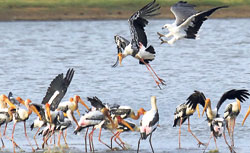As evening approaches, the banks of the Minneriya reservoir become crowded with visitors of a different kind. As the sun slowly retreats from different corners of the scrub jungle the visitors slowly approach the green plains by the receding waters.
One by one they appear until the grassy plains are teeming with them. They eat, drink and frolic with each other. While little ones run around their mothers the solitary males greet each other and exchange pleasantries.
 |
| The gathering: A rare sight in the whole of South Asia |
Don’t be mistaken, this is no ordinary affair. This is in fact a ‘giant’ event- the annual gathering of the gentle jumbos of Sri Lankan jungles at Minneriya. From July to September one can observe hundreds of them on the banks of Minneriya tank, grazing on the grass growing on the rich soil.
For any nature lover this is paradise. Nowhere in the country, would one witness a spectacle of this magnitude. This is the now famous elephant gathering in Minneriya, known to be the largest of its kind even in South Asia.
Elephants from neighbouring jungles come to the Minneriya Reservoir at the height of the dry season in the North Central province. The reservoir gets filled during the monsoon season of November to February and even though the water level dramatically recedes during the dry months, it leaves a rich soil on which grass grows, becoming the main source of food which the elephants depend on during this period.
The Minneriya reservoir built by King Kassapa also attracts many feathered visitors, which fish in the shallow waters of the tank during the dry season. One is guaranteed of spotting painted stork, egrets and the white -bellied fish eagle, among others, feeding in the shallow waters.
The naturalist from Nature Odyssey handling the nature expeditions at Cinnamon Lodge hotel, Tharaka Koggala, who accompanied us on safari says there are close to 160 varieties of birds in Minneriya, and one is sure to sight many of them.
 |
| A white -bellied fish eagle attempts to swoop down among the painted stork. |
On safari, visitors can also see the Grey Langur monkeys, the Spotted Deer, Sambhur and the Jungle Fowl and if one is lucky even a leopard on the prowl. The ideal time to go on safari is late afternoon when the heat cools and the elephants approach the tank bed from their day time shade in the shrub forest of the Minneriya Park, which is about 8890 acres in extent.
During this time, visitors are guaranteed of seeing at least 200 elephants gathered on the bank grazing and drinking water. We were lucky to see a solitary young tusker lazily feeding on the grass on the tank bed.
Among the big adults we spotted a number of baby elephants as young as a week old according to Tharaka. It was touching to see the young calves running between their mothers’ legs, with their tails in the air. The solitary males occasionally greeted another male by entangling their trunks and giving what seemed to be the elephant equivalent of a hug.
The park closes at 6.30 p.m. and after a day out in the wilderness it was time to retreat to my hotel room in Cinnamon Lodge, Habarana. Centrally located with easy access to national nature parks such as Minneriya and Kaudulla, cultural sites such as Sigiriya and Dambulla, the hotel is popular among both local and foreign tourists visiting the area. Built on the border of Habarana tank, the Cinnamon Lodge is the perfect blend of nature and luxury. Spreading over 18 acres one can spot over 130 bird species in the hotel premises itself, a reason on its own to justify a stay there.
The hotel’s butterfly garden, where over 120 types of butterflies breed during the season, is also a colourful spectacle. After spending the afternoon in the park a quiet dinner at the Lodge was a perfect way to end a rather eventful day. |


